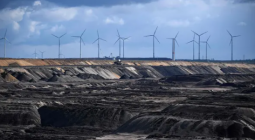Net-zero carbon pledges must be meaningful to avert climate disaster.

More countries are pledging to achieve carbon neutrality. They must now show how they plan to do this.
The administration of US President Joe Biden has pledged 2050 as its deadline for net-zero greenhouse-gas emissions. Earlier, China declared 2060 for its own net-zero date. A debate is under way in India, too, as in much of the rest of the world. In all, some 124 nations out of 202 surveyed in a report published last week have made net-zero pledges ahead of November’s world climate summit in Glasgow, UK (see go.nature.com/2puuzmh). Activities leading up to the United Nations summit include a ‘race to zero’ campaign to get the remaining countries on board by then.
But what does net zero actually mean? In a 2018 special report, the Intergovernmental Panel on Climate Change said that countries must bring carbon dioxide emissions to “net zero” by 2050 to keep global warming to within 1.5 °C of pre-industrial levels. But beyond that, there’s less agreement on which substances net zero applies to. This creates serious ambiguity, and countries and organizations are defining the phrase according to their own criteria. Agreeing on a definition is important for accountability but, most importantly of all, without it, the 2015 Paris climate agreement’s aim to limit warming to between 1.5 °C and 2 °C by mid-century might not be achieved.
Joeri Rogelj at Imperial College London and his colleagues have shown clearly how different definitions and pathways to net zero can have drastically differing outcomes (J. Rogelj et al. Nature 591, 365–368; 2021). For example, reducing CO2 emissions halts warming, but the CO2 that already exists in the atmosphere will remain for hundreds of years. At the same time, cuts to other greenhouse gases could affect warming faster. But eliminating these other gases is more complex than is cutting carbon.
The researchers also warn that the relative quantities of these emissions reductions will also affect the gases’ overall rates of decline. In some scenarios, temperatures might not start to decline, even with emissions reductions. The team rightly urges clarification on three policy areas: the scope of emissions reductions; their adequacy and fairness; and concrete steps towards achieving net zero. A 2050 or 2060 target becomes meaningless without interim milestones.
The Paris climate agreement applies to all greenhouse-gas emissions, but participating countries did not decide how emissions are to be reduced, nor how reductions would be measured. Agreement on both will be priorities for the Glasgow summit, but the information vacuum during the intervening six years has created a space for multiple interpretations and options. So, whereas the European Union’s pledge targets all such gases, China’s plan focuses only on CO2 emissions and does not include methane or nitrous oxide. And the US plan has yet to specify which gases are covered.
Corporations making net-zero pledges are being similarly flexible in their definitions. For some, net zero means removing greenhouse gases from all of their processes, including taking steps to offset historical emissions. But others — such as investment banks and fossil-fuel companies — will continue to invest in fossil fuels while pledging net-zero policies in other areas of their businesses. And this is rightly attracting criticism, not least from the inspirational school climate-strikes movement, Fridays for Future.
Offset risks
Controversy also continues around the word ‘net’ — in that net zero is the balance between emissions produced and emissions removed. Under previous emissions reductions rules that expired in 2020 (under the 1997 Kyoto climate protocol), high-emitting countries were allowed to offset their emissions with the help of lower-emitting countries. They could, for example, buy and sell carbon as a commodity on the many carbon-trading exchanges that have been set up around the world. Carbon trading allows high-emitting countries to reduce their net emissions without actually reducing the overall amount of carbon they release into the atmosphere. These countries could also claim carbon credits if they finance clean energy or plant trees in low-emitting countries.
But if the high emitters increasingly use such measures, the world could reach net zero only in the technical sense. The Paris goal of keeping warming in check is less likely to be achieved if these countries don’t radically bring down their own emissions. The risk is that the world will warm, and that a greater burden — for example, accelerated climate adaptation measures — will then fall on climate-vulnerable countries. This is a real prospect, and is among the reasons why countries most vulnerable to climate change, especially those in the global south, are concerned about the increasing use of offsets to reach net zero.
Although all efforts at decarbonization have some value, the least that must happen is for there to be greater transparency in how countries are achieving their net-zero ambitions — because that will allow researchers to more accurately work out what these pledges mean for achieving the Paris agreement’s goal. What the planet desperately needs is agreed rules and a trusted monitoring mechanism — which this journal has already advocated in other areas of climate policy, such as in financing climate-mitigation and adaptation projects (see Nature 589, 7; 2021).
It is not hard to make pledges towards net zero — especially when the nations and organizations involved can themselves set the parameters for that pledge. But a pledge that doesn’t include meaningful reductions — as opposed to more offsets — increases the risk that catastrophic climate change will become unavoidable.
Nature 592, 8 (2021)
doi: https://doi.org/10.1038/d41586-021-00864-9
31 March 2021
nature





